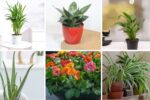Aloe vera is more than just a trendy succulent; it’s a powerhouse plant known for its healing properties, air-purifying ability, and effortless beauty. Whether you want to create a natural remedy station in your kitchen or simply add greenery to your indoor space, aloe vera is a smart choice. Easy to grow and maintain, it thrives indoors with just a bit of attention. In this detailed 1200-word guide, you’ll learn exactly how to start growing aloe vera indoors—from potting to propagation and everything in between.
Why Choose Aloe Vera for Indoor Growing?

Aloe vera (Aloe barbadensis miller) is a succulent plant native to arid regions but perfectly suited for indoor environments. Its thick, fleshy leaves store water, making it highly drought-tolerant and low-maintenance. In addition to its decorative appeal, aloe vera gel offers natural soothing and healing properties, especially for minor burns and skin irritations.
Benefits of Growing Aloe Vera Indoors:
- Requires minimal watering
- Tolerates low humidity
- Helps purify indoor air
- Acts as a natural first-aid plant
- Adds a modern, clean aesthetic to home décor
Step-by-Step Guide to Growing Aloe Vera Indoors

1. Choosing the Right Pot and Soil
Aloe vera’s root system needs excellent drainage to prevent rot. Start with a container that allows water to drain freely and supports healthy root growth.
Pot Requirements:
- Use a terra-cotta or ceramic pot with drainage holes.
- Size should be about 1–2 inches larger than the plant’s root ball.
- Avoid overly large containers that can retain too much moisture.
Soil Requirements:
- Use a cactus or succulent potting mix.
- You can also make your own by mixing 2 parts regular potting soil with 1 part sand or perlite for better drainage.
Pro Tip: Never use regular garden soil—it retains too much water and can lead to root rot.
2. Propagating or Purchasing Your Aloe Vera Plant
You can begin with a small nursery plant or propagate aloe vera from an offshoot (also known as a “pup”).
If Purchasing:
- Look for a healthy plant with firm, green leaves.
- Avoid any with mushy stems or black spots.
If Propagating from a Pup:
- Remove a pup from the mother plant by gently pulling it apart at the base.
- Let it dry out for 1–2 days to form a callus over the cut end (this prevents rot).
- Plant it in the prepared pot with fresh soil and wait a few days before watering.
3. Light Requirements

Aloe vera thrives in bright, indirect sunlight. While it enjoys some direct sun, too much can scorch the leaves.
Ideal Light Conditions:
- Place the pot near a south- or west-facing window.
- If your home lacks natural light, use a grow light for at least 6–8 hours a day.
- Rotate the plant every few days to ensure even growth.
Signs of Too Much Light:
- Leaves turning brown or red
- Scorched tips
Signs of Too Little Light:
- Leggy or droopy leaves
- Pale green color
4. Watering Aloe Vera Indoors
Watering is where most aloe vera plant parents go wrong. This succulent is very sensitive to overwatering.
Watering Tips:
- Let the soil dry out completely between waterings.
- Water every 2–3 weeks in spring/summer, and once a month in fall/winter.
- Water deeply but ensure the excess drains out completely.
- Never let the plant sit in standing water.
Signs of Overwatering:
- Mushy or drooping leaves
- Black spots or root rot
Signs of Underwatering:
- Wrinkled or curling leaves
- Dull or dry appearance
5. Temperature and Humidity Needs

Aloe vera prefers warm temperatures and low humidity, making it perfect for typical indoor climates.
Ideal Conditions:
- Temperature: 60°F to 80°F (15°C to 27°C)
- Humidity: Low to moderate
- Avoid cold drafts, air conditioners, or heaters
Winter Note: Aloe vera is not frost-tolerant. Keep it away from windows that get too cold in winter.
6. Fertilizing Aloe Vera
Although aloe vera doesn’t require frequent feeding, a little boost during the growing season helps.
Fertilizer Tips:
- Use a diluted succulent or houseplant fertilizer once in spring and again in summer.
- Avoid over-fertilizing, which can damage the plant.
7. Pruning and Maintenance

Aloe vera requires very little pruning. However, removing dead or damaged leaves encourages healthy growth.
How to Prune:
- Use a clean, sharp knife or scissors.
- Cut leaves at the base near the soil line.
- Remove any yellowing or brown leaves.
Cleaning Tip: Occasionally wipe the leaves with a damp cloth to remove dust and allow for better photosynthesis.
8. Repotting Aloe Vera
As aloe vera grows, its roots and pups will eventually outgrow the pot.
When to Repot:
- Every 2–3 years or when the roots are crowding the pot
- When the plant becomes top-heavy and starts tipping over
How to Repot:
- Gently remove the plant and loosen the roots.
- Replant in a slightly larger pot with fresh succulent soil.
- Wait 3–5 days before watering to allow the roots to settle.
9. Common Problems and Solutions
Even the easiest plants can have issues. Here are common aloe vera problems and how to fix them:
| Problem | Symptoms | Solution |
|---|---|---|
| Overwatering | Mushy, soft leaves | Reduce watering; check drainage |
| Underwatering | Wrinkled, thin leaves | Increase watering slightly |
| Sunburn | Brown, crispy leaf tips | Move to indirect light |
| Root Rot | Foul smell, blackened base | Remove affected roots, repot in dry soil |
| Pests (like aphids, mealybugs) | Sticky leaves, tiny bugs | Use insecticidal soap or neem oil |
10. Harvesting and Using Aloe Vera
Once your plant matures, you can begin to harvest leaves for personal use.
How to Harvest:
- Choose older, outer leaves first.
- Cut close to the base using a clean knife.
- Let the yellow sap (aloin) drain out, then slice open and scoop the clear gel.
Uses for Aloe Gel:
- Soothe sunburns and cuts
- Moisturize skin
- Add to DIY beauty treatments (face masks, scrubs)
Final Thoughts
Growing aloe vera indoors is both rewarding and practical. With minimal care, this resilient plant adds beauty to your home while providing useful medicinal benefits. Start with the right soil, light, and watering schedule, and you’ll enjoy a thriving aloe plant for years to come. Plus, its ability to produce pups means you can multiply your aloe vera collection and even gift them to friends and family.
So grab a pot, find a sunny windowsill, and start growing your own indoor aloe vera today—it’s one of the easiest, most beneficial houseplants you’ll ever grow.





